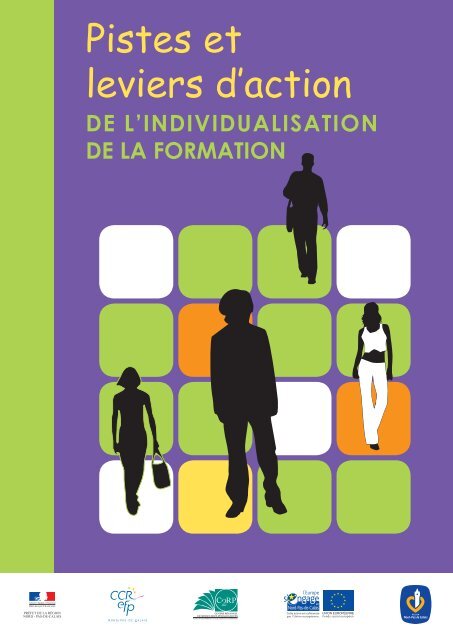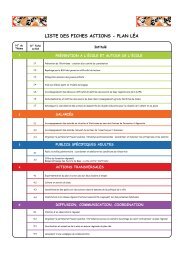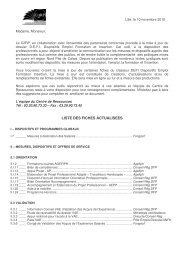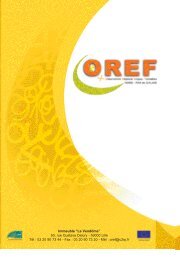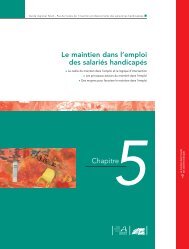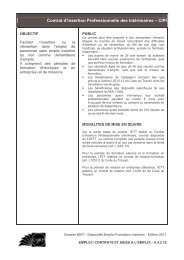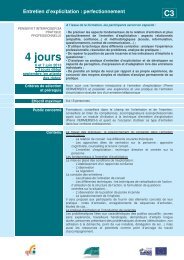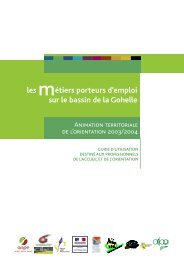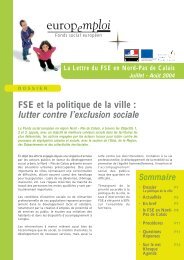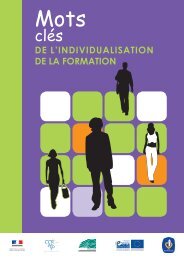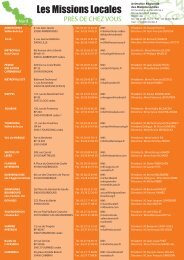es pistes et leviers d'action - C2RP
es pistes et leviers d'action - C2RP
es pistes et leviers d'action - C2RP
- No tags were found...
You also want an ePaper? Increase the reach of your titles
YUMPU automatically turns print PDFs into web optimized ePapers that Google loves.
Pist<strong>es</strong> <strong>et</strong><strong>leviers</strong> d’actionDE L’INDIVIDUALISATIONDE LA FORMATIONPRÉFET DE LA RÉGIONNORD - PAS-DE-CALAISC<strong>et</strong>te action <strong>es</strong>t cofinancée UNION EUROPÉENNEpar l’Union européenne. Fonds social européen
éussite du proj<strong>et</strong> tant prof<strong>es</strong>sionnel que de formation.La constitution de group<strong>es</strong> de travail communs,socl<strong>es</strong> de compétenc<strong>es</strong> <strong>et</strong> individualisation seraientutil<strong>es</strong>, notamment pour préciser la place de l’acquisitionde ce socle dans le parcours de formation, <strong>et</strong>accompagnerait un proc<strong>es</strong>sus partenarial pour uneréponse sur l<strong>es</strong> deux objectifs d<strong>es</strong> publics.5/ Travailler sur la mise en cohérence d<strong>es</strong>outils de positionnement d<strong>es</strong> personn<strong>es</strong>entre l<strong>es</strong> différents intervenants.La multiplicité d<strong>es</strong> outils de positionnement peut poserproblème aux individus en premier lieu, aux différentsintervenants ensuite. Partant de la personne <strong>et</strong>d<strong>es</strong> usag<strong>es</strong> attendus par elle de c<strong>es</strong> positionnements,il conviendrait de réfléchir à leur nombre, leur nature<strong>et</strong> finalité, aux méthod<strong>es</strong> utilisé<strong>es</strong> pour l<strong>es</strong> conduire,aux outils concr<strong>et</strong>s utilisés, ceci dans le sens de la simplification,d’une meilleure cohérence d’ensemble,<strong>et</strong> d’un accent mis au moins autant sur l<strong>es</strong> acquis <strong>et</strong>atouts d<strong>es</strong> personn<strong>es</strong> que sur leur manqu<strong>es</strong>.6/ Donner la priorité aux aspects pédagogiqu<strong>es</strong><strong>et</strong> de prise en compte de la personnepar rapport aux logiqu<strong>es</strong> administrativ<strong>es</strong> <strong>et</strong>financièr<strong>es</strong>.Le souhaitable serait que l<strong>es</strong> pratiqu<strong>es</strong> d’individualisationse rapprochent le plus possibl<strong>es</strong> de pratiqu<strong>es</strong>de personnalisation, avec prise en compte d<strong>es</strong> atoutspotentialités <strong>et</strong> d<strong>es</strong> apprentissag<strong>es</strong> à développer.C<strong>et</strong>te pratique devrait se partager entre l<strong>es</strong> différentsintervenants tout au long du parcours, cela supposede réfléchir aux compétenc<strong>es</strong> d<strong>es</strong> intervenants surce vol<strong>et</strong> <strong>et</strong> aux démarch<strong>es</strong> <strong>et</strong> outils à promouvoir.7/ Développer, aux différents moments d<strong>es</strong>parcours de formation, le mixage d<strong>es</strong> publics.L<strong>es</strong> systèm<strong>es</strong> de formation à parcours individualisés,constituent une opportunité où mixer d<strong>es</strong> publicsdifférents, La confrontation <strong>et</strong> l<strong>es</strong> échang<strong>es</strong> dans ladémarche d’apprentissage sont enrichissants, grâceau croisement d<strong>es</strong> expérienc<strong>es</strong> de vie. Encouragerle mixage entre personn<strong>es</strong> de tranch<strong>es</strong> d’âg<strong>es</strong>, d<strong>es</strong>tatuts (salariés, apprentis <strong>et</strong> demandeurs d’emploi)<strong>es</strong>t bénéfique pour l<strong>es</strong> personn<strong>es</strong> sous condition quec<strong>et</strong>te situation soit prévue <strong>et</strong> exploitée pédagogiquement.8/ Essayer de mieux articuler, voire de coordonnerl<strong>es</strong> modalités d’intervention d<strong>es</strong> financeurs.Selon le financeur, l<strong>es</strong> procédur<strong>es</strong> <strong>et</strong> l<strong>es</strong> montants definancements apparaissent sensiblement différents.C<strong>et</strong> état de fait se justifie par l’hétérogénéité d<strong>es</strong>publics, dispositifs <strong>et</strong> m<strong>es</strong>ur<strong>es</strong> à financer. Néanmoins,d<strong>es</strong> réflexions ou propositions pour tendre vers unecertaine harmonisation <strong>et</strong> non une uniformisation,pourraient être util<strong>es</strong> <strong>et</strong> faciliter la lisibilité du système<strong>et</strong> la g<strong>es</strong>tion d<strong>es</strong> organism<strong>es</strong>.9/ Prendre en considération l’ensemble d<strong>es</strong>coûts dans l<strong>es</strong> modalités de financementd<strong>es</strong> systèm<strong>es</strong> individualisés.La réflexion sur l<strong>es</strong> coûts de l’individualisation sembleimportante pour déterminer exactement l<strong>es</strong> post<strong>es</strong>sourc<strong>es</strong> d’économi<strong>es</strong> de parcours ou d’échelle, maisaussi d’identifier l’ensemble d<strong>es</strong> « surcoûts » qui sontattachés au dispositif individualisé en fonction de lanature <strong>et</strong> de l’ampleur d<strong>es</strong> dispositifs. C<strong>et</strong>te réflexionpourrait être commune financeurs/ opérateurs, <strong>et</strong>déboucher sur d<strong>es</strong> propositions de « post<strong>es</strong>-clefs » <strong>et</strong>de mod<strong>es</strong> de financements différenciés <strong>et</strong> innovants.10/ Le développement de form<strong>es</strong> de travailen commun OPCA, entrepris<strong>es</strong>, organism<strong>es</strong>de formation, salariés.L’individualisation de la formation <strong>et</strong> d<strong>es</strong> parcours faitl’obj<strong>et</strong> de représentations qui varient en fonction d<strong>es</strong>acteurs institutionnels <strong>et</strong> de leur place <strong>et</strong> rôle dans l<strong>es</strong>ystème. C<strong>es</strong> divergenc<strong>es</strong> de vision ne sont pas facilitatric<strong>es</strong>de compréhension, de valeurs partagé<strong>es</strong> <strong>et</strong>d’efficacité d<strong>es</strong> dispositifs. D<strong>es</strong> mod<strong>es</strong> de collaborationperm<strong>et</strong>tant l’émergence de valeurs <strong>et</strong> discourscommuns ou compatibl<strong>es</strong> constitueraient d<strong>es</strong> gag<strong>es</strong>de meilleure efficience.4Individualisation d<strong>es</strong> parcours ● R<strong>es</strong>titution ● Pist<strong>es</strong> <strong>et</strong> <strong>leviers</strong> d’actions ● Mots clés ● Bibliographie
11/ La coordination, si ce n’<strong>es</strong>t le regroupementd’entrepris<strong>es</strong> dans le cadre de ladétermination d<strong>es</strong> b<strong>es</strong>oins individuels deformations qualifiant<strong>es</strong>.Le point de vue d<strong>es</strong> entrepris<strong>es</strong> pour déterminer l<strong>es</strong>b<strong>es</strong>oins en formation sur l<strong>es</strong> aspects contenus <strong>et</strong> formatou pour envisager via la formation, l’accompagnementd<strong>es</strong> personn<strong>es</strong> à reconvertir n’<strong>es</strong>t pas encoreinscrit dans l<strong>es</strong> usag<strong>es</strong>. Il conviendrait de rendreplus compréhensible le système de formation prof<strong>es</strong>sionnellepour l’entreprise, l<strong>es</strong> conditions de mobilisation,l’appréciation d<strong>es</strong> servic<strong>es</strong> <strong>et</strong> d<strong>es</strong> résultats. Laqu<strong>es</strong>tion de l’assise institutionnelle du regroupement(branche, filière, territoriale en interprof<strong>es</strong>sionnel..) sepose.L<strong>es</strong> opportunités pour l’organisme de formation pourraientse m<strong>es</strong>urer sur la veille <strong>et</strong> l’adaptation de l’offre<strong>et</strong> d’un point de vue quantitatif sur l’atteinte d’unseuil néc<strong>es</strong>saire à la mise en place de dispositifs individualisés.12/ Développer d<strong>es</strong> passerell<strong>es</strong> entre dispositifs<strong>et</strong> d<strong>es</strong> partenariats entre organism<strong>es</strong>sous d<strong>es</strong> form<strong>es</strong> à construire ensemble.L<strong>es</strong> partenariats inter-organism<strong>es</strong> de formationexistent déjà en de nombreus<strong>es</strong> occasions, mais demanderaientà être encore étendus <strong>et</strong> formalisés. L<strong>es</strong>partenariats entre organism<strong>es</strong> de formation <strong>et</strong> acteurssocio-économiqu<strong>es</strong> sont moins présents, maisleur développement serait souhaitable, car le chainaged<strong>es</strong> acteurs, en particulier sur un territoire, <strong>es</strong>tune d<strong>es</strong> conditions de concrétisation d<strong>es</strong> parcours.Ce chainage pourrait aussi contribuer au décloisonnementd<strong>es</strong> filièr<strong>es</strong> <strong>et</strong> d<strong>es</strong> m<strong>es</strong>ur<strong>es</strong> de formation pourfaciliter l’individualisation,13/ Développer l’innovation <strong>et</strong> l’expérimentationd‘outils dédiés à l’individualisation,que ce soit au niveau d<strong>es</strong> parcours ou de lasituation pédagogique.L<strong>es</strong> pratiqu<strong>es</strong> d’individualisation d<strong>es</strong> anné<strong>es</strong> 80 <strong>et</strong> 90ont évolué, de nouvell<strong>es</strong> méthod<strong>es</strong> <strong>et</strong> outils sont misen œuvre pour tenir compte d<strong>es</strong> logiqu<strong>es</strong> de parcours<strong>et</strong> de formation actuels. Ce renouveau pédagogique<strong>es</strong>t souvent le fait d<strong>es</strong> acteurs de terrain,conseillers de l’orientation, r<strong>es</strong>ponsabl<strong>es</strong> pédagogiqu<strong>es</strong>,formateurs. Il <strong>es</strong>t généralement produit dansl’action auprès d<strong>es</strong> individus en formation. La formalisation<strong>et</strong> la capitalisation de c<strong>es</strong> pratiqu<strong>es</strong> seraientnéc<strong>es</strong>sair<strong>es</strong> pour ne pas reproduire la « perte de mémoire» d<strong>es</strong> innovations d’il y a vingt ou trente ans.Elle perm<strong>et</strong>trait de constituer une sorte de banquede donné<strong>es</strong> d<strong>es</strong> pratiqu<strong>es</strong> <strong>et</strong> une mémoire d<strong>es</strong> acteursau niveau régional afin de faciliter la généralisationou la diffusion d<strong>es</strong> bonn<strong>es</strong> pratiqu<strong>es</strong>.14/ La création de dispositifs de type package/ boîte à outils généraux intégrant uneoffre de servic<strong>es</strong> globale, <strong>et</strong> adaptable aucas par cas.Ce type d’initiative serait plus particulièrement adaptépour ce qui concerne l<strong>es</strong> publics d’entrepris<strong>es</strong>. Il n<strong>es</strong>’agirait pas en l’<strong>es</strong>pèce de créer d<strong>es</strong> rec<strong>et</strong>t<strong>es</strong> tout<strong>es</strong>fait<strong>es</strong> de l’individualisation, mais bien plutôt d<strong>es</strong> outilsque l<strong>es</strong> acteurs pourraient s’approprier <strong>et</strong> adapteren fonction d<strong>es</strong> situations particulièr<strong>es</strong>.La création de tels « packag<strong>es</strong> » serait le fait d<strong>es</strong> acteursde l’entreprise, mais avec la collaboration d<strong>et</strong>out<strong>es</strong> l<strong>es</strong> personn<strong>es</strong> forc<strong>es</strong> de propositions, <strong>et</strong> aussicell<strong>es</strong> du centre de r<strong>es</strong>sourc<strong>es</strong> régional. L<strong>es</strong> qu<strong>es</strong>tionsdu financement de leur conception, de leur diffusion<strong>et</strong> utilisation sont encore à débattre.15/ Développer la formation <strong>et</strong> la prof<strong>es</strong>sionnalisationd<strong>es</strong> acteurs par l’échange <strong>et</strong>d’analyse d<strong>es</strong> pratiqu<strong>es</strong> prof<strong>es</strong>sionnell<strong>es</strong>.La formalisation d<strong>es</strong> pratiqu<strong>es</strong> à partir du discoursd<strong>es</strong> acteurs eux-mêm<strong>es</strong>, pourrait constituer la basede r<strong>es</strong>sourc<strong>es</strong> collectiv<strong>es</strong> partagé<strong>es</strong> au niveau deregroupements d’organism<strong>es</strong> ou au niveau régional.Ainsi, il perm<strong>et</strong>trait de tendre vers un cadre de référenc<strong>es</strong>partagé<strong>es</strong> <strong>et</strong> contribuerait à la formation permanented<strong>es</strong> intervenants.Individualisation d<strong>es</strong> parcours ● R<strong>es</strong>titution ● Pist<strong>es</strong> <strong>et</strong> <strong>leviers</strong> d’actions ● Mots clés ● Bibliographie 5
16/ Constituer une animation régionale surl<strong>es</strong> multipl<strong>es</strong> modalités de l’individualisation.L’hétérogénéité d<strong>es</strong> pratiqu<strong>es</strong> d’individualisation,<strong>et</strong> l’absence de modèle de système individualisé,militeraient pour le repérage d<strong>es</strong> principal<strong>es</strong> form<strong>es</strong>utilisé<strong>es</strong> tant sur le plan organisationnel que pédagogique<strong>et</strong> financier. Le repérage de c<strong>es</strong> modalitésservirait de cadre <strong>et</strong> d’outil à une animation régionale<strong>et</strong> contribuerait à l’alimentation d’un centre der<strong>es</strong>sourc<strong>es</strong>.17/ Développer de vrai<strong>es</strong> logiqu<strong>es</strong> de fonctionnementterritorial<strong>es</strong>, articulé<strong>es</strong> sur la notionde proj<strong>et</strong> plutôt que sur la simple g<strong>es</strong>tiond’actions.L<strong>es</strong> personn<strong>es</strong> construisant <strong>et</strong> vivant leur parcours trèsmajoritairement sur un territoire bien défini (qui <strong>es</strong>t,en première approximation, le bassin d’emploi), l<strong>es</strong>systèm<strong>es</strong>, parcours <strong>et</strong> pratiqu<strong>es</strong> d’individualisationpourraient mobiliser davantage s<strong>es</strong> r<strong>es</strong>sourc<strong>es</strong> <strong>et</strong> s<strong>es</strong>acteurs. Le territoire ne serait pas alors le simple lieud’application de l’individualisation, mais un de s<strong>es</strong>moteurs.6Individualisation d<strong>es</strong> parcours ● R<strong>es</strong>titution ● Pist<strong>es</strong> <strong>et</strong> <strong>leviers</strong> d’actions ● Mots clés ● Bibliographie
<strong>C2RP</strong>Mission Capitalisation d<strong>es</strong> outils <strong>et</strong> méthod<strong>es</strong> pédagogiqu<strong>es</strong>Immeuble « Le Vendôme »50 rue Gustave Delory59000 LILLETél. : 03 20 90 73 00Fax : 03 20 90 73 40alternance@c2rp.frConception <strong>et</strong> réalisation <strong>C2RP</strong> - Mission Communication - Mai 2012


